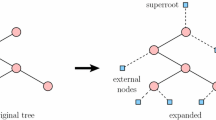Abstract
We consider the problem of collectively locating a set of points within a set of disjoint polygonal regions when neither for points nor for regions preprocessing is allowed. This problem arises in geometric database systems. More specifically it is equivalent to computing theinside join of geo-relational algebra, a conceptual model for geo-data management. We describe efficient algorithms for solving this problem based on plane-sweep and divide-and-conquer, requiringO(n(logn) +t) andO(n(log2 n) +t) time, respectively, andO(n) space, wheren is the total number of points and edges, and (is the number of reported (point, region) pairs. Since the algorithms are meant to be practically useful we consider as well as the internal versions-running completely in main memory-versions that run internally but use much less than linear space and versions that run externally, that is, require only a constant amount of internal memory regardless of the amount of data to be processed. Comparing plane-sweep and divide-and-conquer, it turns out that divide-and-conquer can be expected to perform much better in the external case even though it has a higher internal asymptotic worst-case complexity.
An interesting theoretical by-product is a new general technique for handling arbitrarily large sets of objects clustered on a singlex-coordinate within a planar divide-and-conquer algorithm and a proof that the resulting “unbalanced” dividing does not lead to a more than logarithmic height of the tree of recursive calls.
Similar content being viewed by others
References
Bayer, R., and E. M. McCreight, Organization and Maintenance of Large Ordered Indexes.Acta Informatica,1 (1972), 173–189.
Bentley, J. L., Solutions to Klee's Rectangle Problems. Unpublished manuscript, Dept. of Computer Science, Carnegie-Mellon University, 1977.
Cole, R., Searching and Storing Similar Lists.Journal of Algorithms,7 (1986), 202–220.
Comer, D., The Ubiquitous B-tree.ACM Computing Surveys,11 (1979), 121–137.
Edelsbrunner, H., A New Approach to Rectangle Intersections, Part II.International Journal of Computer Mathematics,13 (1983), 221–229.
Edelsbrunner, H., and L. J. Guibas, Topologically Sweeping an Arrangement.Proceedings of the 18th Annual ACM Symposium on Theory of Computing, 1986, 389–403.
Edelsbrunner, H., L. J. Guibas, and J. Stolfi, Optimal Point Location in a Monotone Subdivision.SIAM Journal on Computing,15 (1986), 317–340.
Güting, R. H., Optimal Divide-and-Conquer to Compute Measure and Contour for a Set of Iso-Rectangles.Acta Informatica,21 (1984), 271–291.
Güting, R. H., Divide-and-Conquer in Planar Geometry.International Journal of Computer Mathematics,18 (1986), 247–263.
Güting, R. H., Geo-Relational Algebra: A Model and Query Language for Geometric Database Systems. In J. W. Schmidt, S. Ceri, and M. Missikoff (eds.),Proceedings of the International Conference on Extending Database Technology, Venice, March 1988, 506–527.
Güting, R. H., Modeling Non-Standard Database Systems by Many-Sorted Algebras. Report 255, Fachbereich Informatik, Universität Dortmund, 1988.
Güting, R. H., and W. Schilling, A Practical Divide-and-Conquer Algorithm for the Rectangle Intersection Problem.Information Sciences,42 (1987), 95–112.
Güting, R. H., and D. Wood, Finding Rectangle Intersections by Divide-and-Conquer.IEEE Transactions on Computers,33 (1984), 671–675.
Hon, R. W., The Hierarchical Analysis of VLSI-Design. Report CMU-CS-83-170, Dept. of Computer Science, Carnegie-Mellon University, 1983.
Kirkpatrick, D. G., Optimal Search in Planar Subdivisions.SIAM Journal on Computing,12 (1983), 28–35.
Leeuwen, J. v., and D. Wood, The Measure Problem for Rectangular Ranges ind-Space.Journal of Algorithms,2 (1981), 282–300.
Lipton, R. J., and R. E. Tarjan, Applications of a Planar Separator Theorem.Proceedings of the 18th Annual IEEE Symposium on Foundations of Computer Science, 1977, 162–170.
McCreight, E. M., Efficient Algorithms for Enumerating Intersecting Intervals and Rectangles. Report CSL-80-9, XEROX Palo Alto Research Center, 1980.
Mehlhorn, K.,Data Structures and Algorithms 3: Multi-dimensional Searching and Computational Geometry. Springer-Verlag, Berlin, 1984.
Nievergelt, J., H. Hinterberger, and K. C. Sevcik, The Grid File: An Adaptable, Symmetric Multikey File Structure.ACM Transactions on Database Systems,9 (1984), 38–71.
Ottmann, Th., and D. Wood, Space-Economical Plane-Sweep Algorithms.Computer Vision, Graphics, and Image Processing,34 (1986), 35–51.
Preparata, F. P., A Note on Locating a Set of Points in a Planar Subdivision.SIAM Journal on Computing,8 (1979), 542–545.
Preparata, F. P., and M. I. Shamos,Computational Geometry: An Introduction. Springer-Verlag, New York, 1985.
Sarnak, N., and R. E. Tarjan, Planar Point Location Using Persistent Search Trees.Communications of the ACM,29 (1986), 669–679.
Six, H.-W., and P. Widmayer, Spatial Searching in Geometric Databases. Report 176 Institut für Angewandte Informatik und Formale Beschreibungsverfahren, Universität Karlsruhe, 1987.
Tamminen, M., Efficient Spatial Access to a Data Base.Proceedings of the ACM SIGMOD International Conference on Management of Data, Orlando, Florida, 1982, 200–206.
Tamminen, M., and R. Sulonen, The EXCELL Method for Efficient Geometric Access to Data.Proceedings of the 19th ACM IEEE Design Automation Conference, 1982, 345–351.
Tilove, R. B., Set Membership Classification: A Unified Approach to Geometric Intersection Problems.IEEE Transactions on Computers,29 (1980), 874–883.
Author information
Authors and Affiliations
Additional information
Communicated by D. T. Lee.
This work was supported by the DFG (Deutsche Forschungsgeneinschaft) under Grant Cr 65–2.
Rights and permissions
About this article
Cite this article
Blankenagel, G., Güting, R.H. Internal and external algorithms for the points-in-regions problem—the inside join of geo-relational algebra. Algorithmica 5, 251–276 (1990). https://doi.org/10.1007/BF01840388
Received:
Revised:
Issue Date:
DOI: https://doi.org/10.1007/BF01840388




